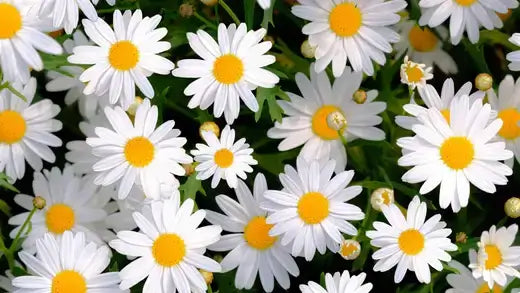The Oxeye daisy, scientifically known as Leucanthemum vulgare, is a charming and resilient perennial flower native to Europe and Asia. It boasts a distinctive appearance that sets it apart from its floral counterparts.
Here is everything you need to know about the Oxeye daisy:
Appearance
The Oxeye Daisy features a classic daisy-like bloom with a prominent yellow disk-shaped center surrounded by delicate white petals. The petals are often slightly notched at the tips, adding a touch of intricacy to the flower's simplicity.
Growth Habit
This perennial herbaceous plant typically reaches about 1 to 3 feet (30 to 90 cm) and spreads through rhizomes. It forms clumps of basal leaves and erect stems that support its cheerful flowers.
Oxeye Daisy Leaves
The leaves of the Oxeye Daisy are lance-shaped and toothed, with a slightly hairy texture. They form a rosette at the base of the plant and gradually decrease in size as they ascend the stem.
Oxeye Daisy Flowers
The flower heads of the Oxeye Daisy are solitary, measuring around 1 to 2 inches (2.5 to 5 cm) in diameter. The bright yellow center comprises numerous tiny disk florets, while the white ray florets surround it in a captivating display.
Cultural Significance and Symbolism of the Oxeye Daisy
Beyond its aesthetic appeal, the Oxeye Daisy carries cultural significance and symbolism.
In folklore and traditional medicine, the Oxeye Daisy was associated with various uses, including herbal remedies for treating ailments and soothing skin irritations.
The Oxeye Daisy is often associated with innocence, purity, and new beginnings. It symbolizes the charm of simplicity and the return of warm seasons.
Ecological Value
As a native wildflower, the Oxeye Daisy plays a role in supporting pollinators, including bees and butterflies, by providing nectar and pollen. Its presence contributes to the health of local ecosystems.
Cultivation Tips and Considerations
Cultivating Oxeye daisies in your garden can be a delightful endeavor, provided you consider certain factors:
- Hardiness Zones
Oxeye Daisies thrive in various climates and are typically hardy in U.S.D.A. zones 3 to 9. Check your specific hardiness zone to ensure they are suitable for your region.
- Sunlight
These daisies flourish in full sun to partial shade. While they can tolerate some shade, they tend to produce more abundant blooms when exposed to ample sunlight.
- Soil
Oxeye Daisies prefer well-draining soil. They can tolerate various soil types, but good drainage is essential to prevent root rot.
- Watering
Once established, Oxeye Daisies are relatively drought-tolerant and require minimal watering. Allow the soil to dry between waterings.
- Propagation
Propagate Oxeye Daisies through division, seeds, or transplants. The division is best done in spring or fall while sowing seeds directly in early spring can produce beautiful blooms.
- Maintenance
Oxeye Daisies are low-maintenance plants. Deadhead spent flowers to encourage prolonged blooming. In late fall, consider leaving some seed heads for birds to enjoy.
- Invasive Potential
While beloved, the Oxeye Daisy can become invasive in some regions, out-competing native plants. Check with local authorities to ensure its cultivation is appropriate for your area.
- Companion Plants
Pair Oxeye Daisies with other native wildflowers, grasses, and perennials to create a vibrant and ecologically beneficial garden.
The Oxeye Daisy evokes a sense of nostalgia and natural beauty. Its timeless appearance, cultural symbolism, and ecological value make it a cherished addition to gardens, meadows, and landscapes. Whether dotting the countryside or standing in your garden, the Oxeye Daisy reminds you of the natural world's simple yet profound pleasures. By understanding its characteristics and cultivating them responsibly, you can create a harmonious and captivating space that celebrates the elegance of this charming wildflower.
Shop Our Oxeye Daisies
Visit our online shop for a wide selection of plants and trees, or come say hi at our store location in Tennessee!
We offer fast shipping nationwide so you can start transforming your garden today!
If you have any questions about Oxeye daisies or if you have any other plant needs, don't hesitate to contact us at customerservice@tennesseewholesalenursery.com, we'd love to hear from you!
